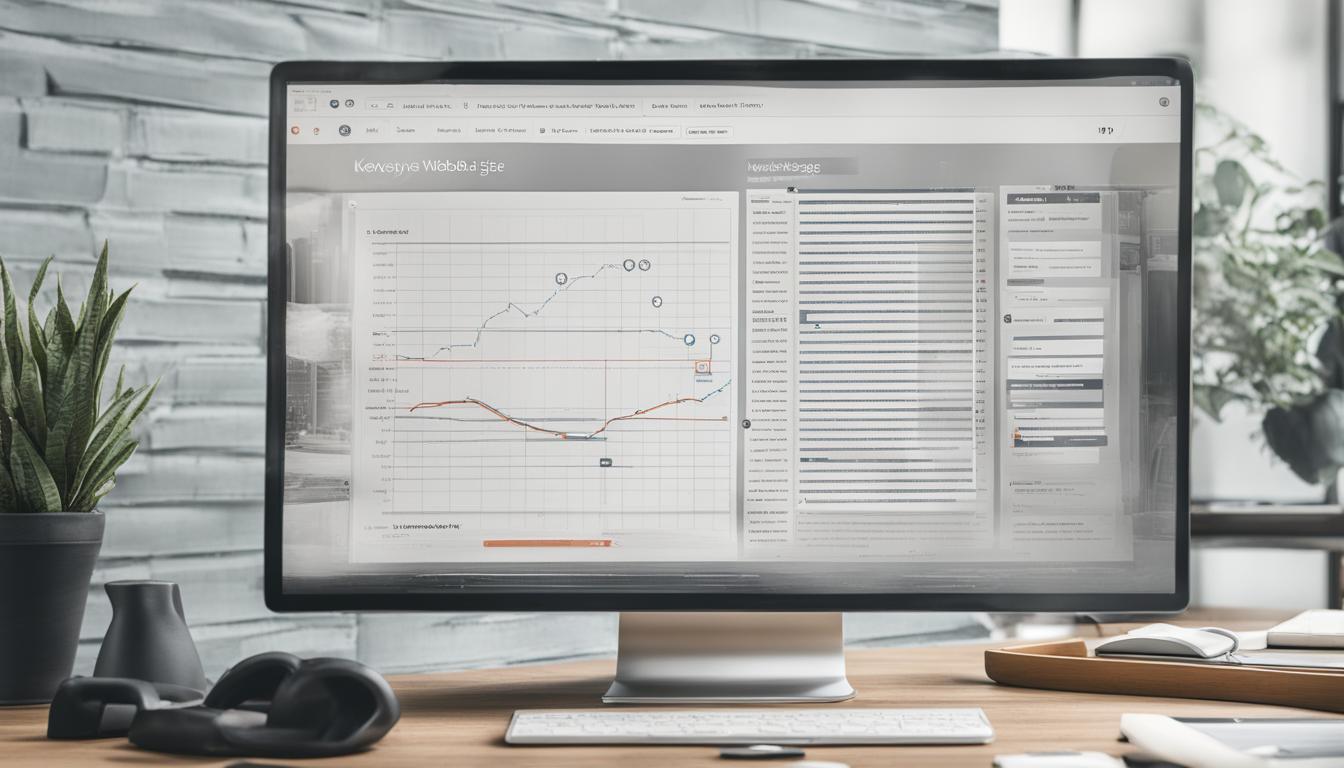Welcome to my comprehensive guide on creating optimized content for search engines. In this guide, I will provide strategies and techniques that can help you boost your website’s visibility and improve your search engine rankings. By implementing SEO best practices and creating SEO-friendly content, you can attract more visitors and increase organic traffic to your website.
Key Takeaways:
- Creating SEO-friendly content is crucial for improving your website’s visibility on search engines.
- Implementing SEO best practices can help you attract more visitors and increase organic traffic.
- Optimizing your content for search engines involves using relevant keywords and following content structure and formatting guidelines.
- Regularly evaluating and updating your content keeps it relevant and aligned with SEO trends.
- High-quality backlinks and social media promotion play a significant role in off-page optimization.
Understanding Quality Content for Search Engines
Quality content is a crucial aspect of optimizing your website for search engines. In order to rank higher in search engine results and attract organic traffic, it’s important to create content that aligns with Google’s framework for quality. While following Google’s guidelines is essential, it’s equally important to go beyond them and focus on creating unique and valuable content that resonates with your audience.
One key aspect of quality content is avoiding logical inconsistencies. These inconsistencies can not only confuse readers but also undermine the credibility of your content. By carefully reviewing your content for logical coherence, you can ensure that your message is clear and logical, and that it effectively conveys information to your audience.
Persuasive writing is another crucial element of quality content. By crafting compelling and persuasive content, you can engage your readers and encourage them to take action. This involves understanding your target audience, their needs, and their pain points, and addressing them effectively in your content.
Additionally, providing unbiased information is key to creating quality content. While it’s important to communicate your unique perspective and expertise, it’s equally important to present information objectively and without bias. This helps in building trust among your readers and establishing your website as a reliable source of information.
Understanding Quality Content for Search Engines Table
| Aspect of Quality Content | Explanation |
|---|---|
| Logical Consistency | Avoid logical inconsistencies in your content to maintain credibility and clarity |
| Persuasive Writing | Create content that engages and convinces your readers to take action |
| Unbiased Information | Present information objectively and without bias to build trust |

Reviewing AI-Generated Content for Accuracy
AI-generated content is becoming increasingly prevalent in today’s digital landscape. While AI has the potential to streamline content creation processes, ensuring accuracy remains a crucial task. Detecting AI content and reviewing it for accuracy is essential to maintain credibility and provide reliable information to readers.
When dealing with AI-generated content, relying solely on AI detection tools may not always be sufficient. These tools may not be foolproof and can sometimes miss instances of AI-generated content. Therefore, it is important to adopt a cautious and critical approach when reviewing content.
“It is important to adopt a cautious and critical approach when reviewing AI-generated content.”
One effective method is to examine the content for any signs of automation. Look for patterns, repetitive sentence structures, or inconsistencies that may indicate the content was generated by AI. Pay attention to the writing style and tone; AI-generated content can sometimes lack the natural flow and authenticity of human-written content.
Additionally, it is crucial to consider the ethical implications of using AI-generated content. Transparency is key, and if AI is involved in the content creation process, it should be clearly disclosed to readers. This helps to maintain trust and ensures that readers have a comprehensive understanding of how the content was produced.
The Importance of Reviewing AI-Generated Content:
Reviewing AI-generated content for accuracy is vital in today’s digital landscape. It helps maintain credibility, ensures the reliability of information, and fosters a trustworthy relationship with readers. By establishing effective methods for detecting AI content and implementing ethical practices, we can harness the benefits of AI while upholding the standards of quality content.
Ensuring Data Accuracy and Up-to-Date Information
When it comes to creating optimized content for search engines, data accuracy and up-to-date information are paramount. Inaccurate or outdated data can not only harm the credibility of your content but also lead to negative user experiences. As an SEO copywriter, it’s essential to carefully evaluate and verify the accuracy of the data you use to maintain the integrity and reliability of your content.
To ensure data accuracy, start by using reputable sources for your information. Citing authoritative websites, industry reports, or studies can add credibility to your content. Additionally, double-check the accuracy of your data by cross-referencing it with multiple sources. This can help catch any discrepancies or errors that may have been overlooked initially.
Regular content auditing is another vital step in maintaining data accuracy. By reviewing your existing content on a consistent basis, you can identify outdated information or incorrect data and make the necessary updates. This helps ensure that your content remains relevant and reliable for both search engines and your audience.
Benefits of Ensuring Data Accuracy:
- Builds trust with your audience: Providing accurate information establishes your credibility and expertise in your industry.
- Improves user experience: Accurate data enhances the value of your content and helps users find the information they need.
- Boosts search engine rankings: Search engines prioritize high-quality, accurate content, making it more likely to rank higher in search results.
Remember, data accuracy is not a one-time task but an ongoing commitment. Continuously reviewing and updating your content ensures that it remains accurate, reliable, and valuable for your audience.
| Data Accuracy Tips | Importance |
|---|---|
| Use reputable sources | Establishes credibility |
| Verify data from multiple sources | Ensures accuracy |
| Regularly audit content | Maintains relevancy |

In conclusion, ensuring data accuracy and providing up-to-date information are crucial for creating optimized content for search engines. By using reputable sources, verifying data accuracy, and regularly auditing your content, you can maintain the integrity of your information and deliver valuable content to your audience.
Mastering Grammar and Formatting for Readability
Proper grammar and formatting are essential for creating readable and engaging content that resonates with your audience. Grammatical errors and inconsistent formatting can not only harm the credibility of your content but also make it difficult for readers to understand your message. To ensure your content is clear, professional, and easy to read, there are several key areas to focus on.
Grammar Errors
Grammar errors can undermine the quality of your content and leave readers with a negative impression. To avoid grammar mistakes, it’s important to have a solid understanding of grammar rules and principles. Take the time to proofread your content carefully, checking for common errors such as subject-verb agreement, verb tense consistency, and proper punctuation. If grammar is not your strong suit, consider using grammar-checking tools or hiring a professional editor to review your content.
Formatting
In addition to grammar, formatting plays a crucial role in enhancing the readability of your content. Use headings and subheadings to break up long blocks of text and guide readers through your content. Bullet points and numbered lists can also help organize information and make it easier to digest. Additionally, consider using bold or italic font styles to emphasize important points and draw attention to key information. Consistent formatting throughout your content creates a visually appealing and professional appearance.
Readability
Optimizing readability is crucial for keeping readers engaged and ensuring they can easily comprehend your content. When writing, aim for clarity and simplicity. Use concise sentences and avoid overly technical or jargon-heavy language that may confuse your audience. Break up paragraphs into shorter, more manageable chunks. Consider the overall structure and flow of your content, ensuring that ideas are presented logically and coherently. By prioritizing readability, you can create content that is accessible and enjoyable for your readers.
| Common Grammar Errors | Formatting Tips |
|---|---|
|
|
By mastering grammar rules, paying attention to formatting, and prioritizing readability, you can create content that is not only well-written but also easily understood by your audience. Remember to proofread your content and consider feedback from readers to continually improve the grammar and formatting of your work.

The Importance of Heading Tags and Meta Tags for SEO
In the world of search engine optimization (SEO), heading tags and meta tags play a crucial role in improving the visibility of your website. These HTML tags provide valuable information to search engines and users, helping them understand the structure and relevance of your content. By optimizing heading tags and meta tags, you can enhance your on-page optimization and increase your chances of ranking higher in search engine results.
Heading tags, marked from H1 to H6, are used to define the hierarchy and structure of your content. Search engines analyze these tags to understand the main topics and subtopics of your page. By using descriptive and keyword-rich heading tags, you can guide search engines through your content and improve its overall readability and user experience. It’s important to note that the H1 tag should only be used once per page and represent the main topic of your content.
Meta tags, on the other hand, provide additional information about your webpage. The most important meta tags for SEO are the title tag and meta description. The title tag appears as the clickable headline in search engine results and should accurately reflect the content of your page while incorporating relevant keywords. The meta description, which appears below the title tag, gives users a brief summary of your page’s content. By crafting compelling and informative meta tags, you can increase the click-through rate from search engine results, ultimately driving more organic traffic to your website.
Optimizing Heading Tags for Better SEO
When optimizing heading tags, keep the following best practices in mind:
- Use only one H1 tag per page to represent the main topic.
- Use H2 to H6 tags to structure your content hierarchically.
- Incorporate relevant keywords into your heading tags.
- Make your heading tags descriptive and concise.
- Avoid using heading tags solely for stylistic purposes.
Optimizing Meta Tags for Improved Search Results
To optimize your meta tags, follow these recommendations:
- Write compelling and relevant title tags that accurately describe your page’s content.
- Include your target keywords naturally in the title tag.
- Keep your title tag length under 60 characters to ensure it displays properly in search engine results.
- Create unique and informative meta descriptions for each page.
- Use action-oriented language and a call-to-action to encourage users to click on your result.
By implementing these best practices and optimizing your heading tags and meta tags, you can improve your on-page optimization and increase your chances of ranking higher in search engine results.
| Heading Tag | Meta Tag | Purpose |
|---|---|---|
| H1 | N/A | Represents the main topic of the page |
| H2-H6 | N/A | Structures the content hierarchically |
| N/A | Title Tag | Clickable headline in search engine results |
| N/A | Meta Description | Brief summary of the page’s content |

Building High-Quality Backlinks for Off-Page Optimization
Building high-quality backlinks is a crucial aspect of off-page optimization. High-quality backlinks not only drive traffic to your website but also enhance your website’s authority and visibility in search engine rankings. Off-page optimization is all about improving your website’s reputation and credibility in the eyes of search engines. By acquiring relevant, authoritative backlinks from reputable websites, you signal to search engines that your website is a trustworthy source of information.
The key to building high-quality backlinks lies in focusing on relevance and authority. It’s important to seek backlinks from websites that are related to your industry or niche. For example, if you run a fitness blog, a backlink from a reputable fitness magazine would carry more weight than a backlink from a random blog. Additionally, it’s crucial to prioritize websites with high domain authority, as these websites have a stronger influence on search engine rankings.
One effective strategy for building high-quality backlinks is outreach. Reach out to relevant websites and offer them valuable content or resources that they can link back to. This could be in the form of guest blog posts, expert opinions, or original research. By providing something of value, you increase the likelihood of other websites linking back to your content. Additionally, leveraging your network and establishing relationships with industry influencers can also be a fruitful way to acquire high-quality backlinks.
| Benefits of High-Quality Backlinks | Effective Link Building Strategies |
|---|---|
|
|
Remember, building high-quality backlinks is a long-term strategy that requires patience and consistency. It’s important to continuously monitor and evaluate the quality of your backlinks to ensure they align with your website’s goals and objectives. By building a strong network of high-quality backlinks, you can boost your website’s visibility, attract more organic traffic, and ultimately drive the success of your online presence.

Leveraging Social Media for Off-Page Optimization
Social media promotion plays a vital role in off-page optimization and increasing brand awareness. By actively engaging with your target audience on platforms like Facebook, Instagram, and Twitter, you can drive traffic to your website and enhance your online presence. Social media platforms provide an opportunity to connect with your audience on a more personal level, build trust, and establish yourself as an industry authority.
One of the key benefits of leveraging social media for off-page optimization is the ability to expand your reach and attract a wider audience. By creating compelling and shareable content, you can encourage your followers to share your posts, increasing the visibility of your brand and driving traffic back to your website. Additionally, social media platforms provide valuable data and analytics that can help you understand your audience better and refine your marketing strategies.
“Social media is not just about blasting your promotional content; it’s about building relationships and engaging with your audience.”
Building Brand Awareness
Social media platforms offer an excellent opportunity to build brand awareness and showcase your unique value proposition. By consistently posting high-quality content that aligns with your brand’s voice and values, you can create a cohesive brand image that resonates with your target audience. Utilize hashtags, mentions, and tags to increase the visibility of your brand and encourage user-generated content.
Furthermore, social media platforms allow you to monitor conversations related to your brand and industry. By actively participating in these conversations and addressing customer concerns or inquiries, you can build trust and credibility. Responding promptly and in a professional manner shows your audience that you value their input and are dedicated to providing excellent customer service.
| Social Media Benefits | Examples |
|---|---|
| Increased website traffic | Sharing blog posts, product announcements, and exclusive offers. |
| Improved brand visibility | Creating engaging and shareable content, utilizing hashtags and mentions. |
| Enhanced customer engagement | Participating in conversations, responding to comments and inquiries. |
Remember, social media is not just about self-promotion; it’s about building relationships, engaging with your audience, and providing value. By consistently delivering informative and entertaining content, you can foster a loyal community of followers who will not only engage with your brand but also become advocates for your products or services.

Understanding the Importance of Keyword Research
In order to optimize your website for search engines, it is essential to understand the importance of keyword research. Conducting thorough keyword research allows you to gain valuable insights into the search terms used by potential customers, helping you align your content with their search intent.
By analyzing keyword trends and identifying relevant keywords for your industry, you can create targeted content that is more likely to appear in organic search results. Understanding the language and phrases that your target audience uses is key to reaching them effectively.
Keyword research goes beyond simply finding popular keywords. It involves understanding the search intent behind those keywords. For example, if someone is searching for “best running shoes,” their intent might be to find a review or a place to buy them. By understanding this intent, you can tailor your content to match what the user is looking for.
Why is Search Intent Important?
Understanding search intent is crucial because it helps you deliver the right content to the right audience at the right time. By aligning your content with the intent behind specific keywords, you can increase the chances of attracting qualified traffic to your website.
For example, if your website sells running shoes, and someone searches for “how to choose running shoes,” their intent is likely informational rather than transactional. By creating a comprehensive guide on how to choose running shoes based on different criteria, you can establish your website as a trustworthy source of information and potentially convert those visitors into customers.
The Role of Organic Search Results
Organic search results are an essential component of driving traffic to your website. When your website appears in the top search results for relevant keywords, it increases the visibility and exposure of your brand to potential customers. By incorporating the right keywords within your content, you can improve your chances of ranking higher in organic search results.
However, it’s important to note that keyword research is an ongoing process. Search trends and user behavior can change over time, so it is crucial to regularly review and update your keyword strategy to stay ahead of the competition and maintain your visibility in search engine results.

| Keyword Research Benefits | Effect on SEO |
|---|---|
| Understanding user search behavior | Helps in creating relevant content |
| Discovering new content ideas | Increases website visibility |
| Identifying search trends | Improves chances of ranking higher |
Optimizing Content with Target Keywords
When it comes to SEO, optimizing your content with target keywords is crucial for improving your website’s visibility on search engines. By strategically integrating relevant keywords into your content, you can increase your chances of ranking higher in search engine results and attracting organic traffic. Here are some techniques to optimize your content with target keywords:
1. Keyword Research
Before you can optimize your content with target keywords, it’s important to conduct thorough keyword research. Identify relevant keywords that are commonly searched by your target audience. Use keyword research tools to explore search volume, competition, and search intent. This research will help you understand what keywords to focus on and how to tailor your content accordingly.
2. Keyword Integration
Once you have identified your target keywords, it’s time to integrate them naturally into your content. Avoid keyword stuffing, which can harm your search engine rankings. Instead, aim for a balanced and organic integration of keywords throughout your content. Incorporate them into your headlines, subheadings, and body text in a way that makes sense and provides value to your readers.
3. Content Optimization
In addition to keyword integration, optimizing your content involves other factors as well. Pay attention to your content structure, headings, and formatting. Use descriptive and compelling titles and headings that include relevant keywords. Break up your content into easily digestible sections with clear subheadings. Also, make sure your content is user-friendly and visually appealing by incorporating images, bullet points, and relevant tables or lists.
By implementing these techniques, you can optimize your content with target keywords and improve your website’s visibility on search engines. Remember to regularly evaluate and update your content to stay relevant to your audience and maintain your search engine rankings.

| Benefits of Optimizing Content with Target Keywords | Challenges of Optimizing Content with Target Keywords |
|---|---|
|
|
Optimizing Meta Tags for Improved Search Engine Indexing
When it comes to optimizing your website for search engines, meta tags play a crucial role in improving your search engine indexing. The two most important meta tags are the title tag and the meta description. These tags not only provide valuable information to search engines but also entice users to click on your website in search engine results.
The title tag is the HTML element that defines the title of a webpage. It appears as the clickable headline in search engine results. It’s important to craft a compelling and concise title that accurately reflects the content of your webpage and includes relevant keywords. By doing so, you can increase your click-through rate and attract more organic traffic to your website.
The meta description, on the other hand, provides a brief summary of the content on your webpage. It appears beneath the title tag in search engine results. A well-crafted meta description not only gives users an idea of what to expect from your webpage but also includes relevant keywords that can improve search engine visibility. It’s important to keep the meta description within the recommended character limit to ensure it is fully displayed in search results.
| Meta Tag | Purpose | Best Practices |
|---|---|---|
| Title Tag | Defines the title of the webpage | Include relevant keywords, keep it concise and compelling |
| Meta Description | Provides a summary of the webpage content | Include relevant keywords, stay within the character limit |
Crafting compelling meta tags requires a balance between optimizing for search engines and appealing to users. Remember, your goal is to attract organic traffic to your website, so make sure your meta tags accurately represent your content and entice users to click through to your webpage.
By optimizing your meta tags, you can improve your website’s search engine indexing and increase your click-through rate. Take the time to carefully craft your title tags and meta descriptions, ensuring they accurately reflect your content and include relevant keywords. By doing so, you can enhance your search engine visibility and attract more organic traffic to your website.

Understanding the Role of URL Structure in SEO
When it comes to optimizing your website for search engines, URL structure plays a significant role in improving your website’s visibility and ranking. A well-optimized URL structure not only helps search engines understand the content of your pages but also provides a better user experience for your visitors. In this section, we will explore the importance of URL structure optimization and provide you with tips to make the most out of it.
Canonical URLs: Avoiding Duplicate Content Issues
One crucial aspect of URL structure optimization is the use of canonical URLs. Canonical URLs help search engines distinguish between different versions of the same content, preventing the issue of duplicate content. When search engines encounter multiple URLs with similar or identical content, they may get confused about which version to index, which can negatively impact your website’s SEO performance.
By implementing canonical URLs, you specify the preferred version of your content, signaling to search engines that it is the authoritative and original source. This helps consolidate the ranking signals and prevents dilution of your website’s SEO value. Additionally, canonical URLs ensure that any external links or social shares are attributed to the correct URL, further improving your website’s visibility.
URL Parameters: Control and Optimize Your Website’s Crawling and Indexing
URL parameters are often used to track user behavior or serve dynamic content on websites. However, they can also create challenges when it comes to SEO. Search engines may treat URLs with different parameters as unique pages, leading to duplicate content issues. To avoid this, it’s crucial to properly manage and optimize URL parameters.
One way to optimize URL parameters is by using the URL parameter handling tool offered by Google Search Console. This tool allows you to specify how search engines should handle URLs with specific parameters, such as whether they should be crawled or indexed. By configuring the parameters correctly, you can ensure that search engines focus on crawling and indexing the most relevant and valuable pages on your website, improving your overall SEO performance.

| Benefits of URL Structure Optimization | Challenges of URL Structure Optimization |
|---|---|
|
|
By optimizing your URL structure, you can enhance your website’s visibility, improve user experience, and boost your SEO performance. Remember to implement canonical URLs to avoid duplicate content issues and manage URL parameters effectively to control crawling and indexing. By following these best practices, you can ensure that search engines understand your website’s content and deliver it to the right audience, driving organic traffic and improving your search engine rankings.
The Importance of Content Structure and Formatting
When it comes to creating SEO-friendly content, the importance of content structure and formatting cannot be overstated. A well-structured piece of content not only enhances readability but also improves the overall user experience. By organizing your content into logical sections using headings, subheadings, and bullet points, you make it easier for readers to navigate and understand your message.
One effective way to enhance content structure is by using descriptive heading tags, such as H1, H2, and H3, to divide your content into meaningful sections. These heading tags not only guide the reader through your content, but they also help search engines understand the hierarchy of information on your page. This, in turn, can improve your search engine optimization and increase your chances of ranking higher in search engine results.
Formatting is another crucial aspect of content optimization. By using appropriate formatting techniques, such as bold or italic text, bullet points, and numbered lists, you can highlight key information, break up large blocks of text, and make your content more scannable. This is particularly important for online readers who tend to skim through content rather than reading every word. By formatting your content effectively, you can grab their attention and keep them engaged.
| Benefits of Content Structure and Formatting | Techniques for Effective Formatting |
|---|---|
|
|
By paying attention to your content structure and formatting, you can create a more engaging and user-friendly experience for your readers. Remember, a well-structured and properly formatted piece of content not only enhances readability but also contributes to your overall SEO efforts. So, take the time to organize your content into logical sections and use formatting techniques that make your content easy to read and navigate.
The Essential Role of Editing in SEO
Editing plays a crucial role in optimizing your content for search engines. It involves a meticulous review and refinement process that ensures your content meets SEO best practices and delivers value to readers. Quality editing not only improves the overall readability and credibility of your content, but it also helps in optimizing old webpages to maintain their relevance and effectiveness.
When it comes to content editing, it is essential to have a structured and quality editing process in place. This process should include reviewing the content for grammar errors, spelling mistakes, and inconsistencies. Additionally, it is important to ensure that the content is well-organized and follows a logical flow. By addressing these factors, you can enhance the overall quality and readability of your content.
Optimizing old webpages is also a crucial aspect of editing in SEO. As your website grows and evolves, it’s important to periodically review and update older content to ensure it remains relevant and aligns with current SEO trends. This includes updating keywords, refreshing statistics, and incorporating new information. By optimizing old webpages, you can maximize their potential to attract organic search traffic and improve your website’s overall performance.

The Benefits of Quality Editing in SEO
Implementing a quality editing process in your content creation strategy offers several benefits. Firstly, it helps in improving the readability and user experience of your content. Well-edited content is easier to navigate and understand, increasing the chances of users staying on your website and engaging with your content.
Secondly, quality editing ensures that your content aligns with SEO best practices. This includes using relevant keywords naturally throughout your content, optimizing meta tags, and following proper heading structure. By editing your content with SEO in mind, you can improve search engine visibility and increase organic traffic to your website.
Lastly, editing plays a vital role in maintaining the credibility and trustworthiness of your content. By thoroughly reviewing your content for accuracy, verifying data sources, and eliminating logical inconsistencies, you can establish yourself as a reliable source of information within your industry. This leads to increased brand authority and a positive reputation amongst both readers and search engines.
| Benefits of Quality Editing in SEO |
|---|
| Enhances readability and user experience |
| Aligns content with SEO best practices |
| Improves search engine visibility and organic traffic |
| Establishes credibility and trustworthiness |
Conclusion
In conclusion, mastering optimized content for search engines is crucial for enhancing website visibility and driving organic search traffic. By implementing the strategies and techniques discussed in this guide, you can create SEO-friendly content that attracts visitors and improves your search engine rankings.
Remember, creating optimized content involves understanding the importance of quality, accuracy, and up-to-date information. By reviewing AI-generated content, ensuring data accuracy, and mastering grammar and formatting, you can enhance the credibility and readability of your content.
Additionally, optimizing your content with target keywords, leveraging high-quality backlinks and social media promotion, and conducting effective keyword research can further boost your website’s visibility and attract more organic search traffic. Don’t forget the significance of optimizing meta tags, URL structure, and content structure and formatting to improve search engine indexing and user experience.
Regularly evaluating and updating your content based on SEO trends and best practices is essential to stay ahead in the ever-evolving digital landscape. By continuously refining and optimizing your content, you can maximize your website’s potential and drive sustainable organic search traffic.
FAQ
What is the importance of creating quality content for search engines?
Creating quality content is crucial for optimizing your website for search engines and improving your search engine rankings. It helps to attract organic traffic and engage your audience.
How can I ensure that my content meets the guidelines for high-quality content?
In addition to following Google’s guidelines, focus on creating unique and valuable content that resonates with your audience. Get rid of logical inconsistencies, master persuasive writing, and offer unbiased information.
What should I consider when reviewing AI-generated content for accuracy?
While there are AI detection tools available, they may not always be reliable. It’s important to review AI-generated content for accuracy manually. Also, consider the ethical implications of using AI-generated content without disclosing it to readers.
How can I maintain the accuracy of the data used in my content?
To maintain data accuracy, carefully evaluate and verify the data sources you use. Regularly review and update your content to ensure it remains accurate and relevant.
How can grammar errors and inconsistent formatting affect the credibility of my content?
Grammar errors and inconsistent formatting can harm the credibility of your content and make it difficult for readers to understand. Master grammar rules, proofread your content, and ensure proper formatting to enhance readability and credibility.
How do heading tags and meta tags contribute to on-page optimization?
Heading tags and meta tags play a crucial role in guiding search engines and users through your content effectively. Use descriptive heading tags and optimize meta tags to improve your website’s visibility on search engines.
Why is building high-quality backlinks important for off-page optimization?
Building high-quality backlinks from reputable websites enhances your website’s authority and visibility. Focus on acquiring backlinks from authoritative sources within your industry and implement effective link building strategies to drive organic traffic.
How can social media promotion contribute to off-page optimization?
Actively engaging with your target audience on social media platforms like Facebook, Instagram, and Twitter can drive traffic to your website, increase brand awareness, and enhance your online presence.
What is keyword research and why is it important for SEO?
Keyword research involves analyzing the search terms used by potential customers. By conducting keyword research, you can understand user search intent and tailor your content accordingly, improving your visibility in organic search results.
How can I optimize my content with target keywords?
Identify relevant keywords and integrate them naturally into your content. By doing so, you can increase your chances of ranking higher in search engine results.
What is the importance of optimizing meta tags?
Optimizing meta tags, including the title tag and meta description, is crucial for improving your website’s search engine indexing. Craft compelling meta tags that accurately reflect your content and include relevant keywords to increase your click-through rate from search engine results.
How does URL structure optimization impact SEO?
Optimizing your URL structure by creating URLs that are easy to read and using canonical URLs to avoid duplicate content issues enhances search engine crawling and indexing of your website.
How does content structure and formatting affect the user experience?
Organizing your content into logical sections using headings, subheadings, and bullet points enhances the user experience by making it easier for readers to navigate and understand your content.
What is the role of editing in SEO?
Editing plays a crucial role in optimizing your content for search engines. Thoroughly edit your content to ensure it meets SEO best practices and provides value to readers. Asking critical questions about its quality during the editing process is important.
Source Links
- https://searchengineland.com/mastering-content-quality-guide-433615
- https://medium.com/@copydashai/mastering-the-art-of-search-engine-optimization-seo-a-guide-for-digital-marketers-e8c5948220d8
- https://www.triangledirectmedia.com/blog/mastering-seo-the-ultimate-guide-to-search-engine-optimization-for-your-website.html

